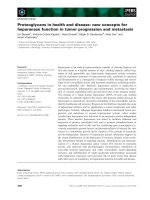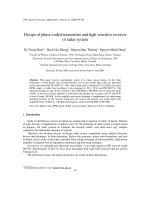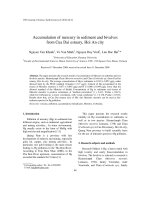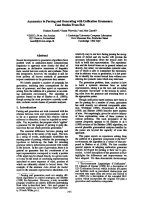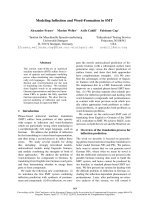Báo cáo " Accumulation of mercury in sediment and bivalves from Cua Dai estuary, Hoi An city " ppt
Bạn đang xem bản rút gọn của tài liệu. Xem và tải ngay bản đầy đủ của tài liệu tại đây (122.5 KB, 7 trang )
VNU Journal of Science, Earth Sciences 26 (2010) 48-54
48
Accumulation of mercury in sediment and bivalves
from Cua Dai estuary, Hoi An city
Nguyen Van Khanh
1
, Vo Van Minh
1
, Nguyen Duy Vinh
1
, Luu Duc Hai
2,
*
1
University of Education, Danang University,
2
Faculty of Environmental Sciences, Hanoi University of Science, VNU, 334 Nguyen Trai, Hanoi, Vietnam
Received 17 December 2009; received in revised form 31 December 2009
Abstract. The paper presents the research results of accumulation of Mercury in sediment and two
bivalves species: Heamolymph Clam (Meretrix meretrix) and Clam (Corbicula sp.) from Cua Dai
estuary, Hoi An city. The average concentration of Hg in sediments is 0.145 ± 0.052 μg/g, under
allowed limit by the PELS standard (Canada) (≤ 0.7 μg/g). Content of Hg accumulated in the
tissues of Meretrix meretrix is 0.073 ± 0.045 μg/g and H is 0.066 ± 0.044 μg/g, lower than the
allowed standard of the Ministry of Health. Concentration of Hg in sediments and tissues of
Meretrix meretrix is positive correlation, at "medium correlation” (r = 0.311, Pvalue = 0.415),
while for Corbicula sp. is lower correlation, with "weak correlation” (r = 0.138, Pvalue = 0.722).
Results show that, at Cua Dai estuary (city of Hoi An), Meretrix meretrix can be used as bio-
indicator species for Hg pollution.
Keywords: toxicity, pollution, accumulation, bioindicator, Meretrix, Corbicula.
1. Introduction
∗
Pollution of mercury (Hg) in sediments has
different origins, such as industrial, agricultural
and mining activities In water environment,
Hg usually exists in the form of MeHg with
high toxicity and magnification [1-3].
Quang Nam is a province with fast
development of industry and mining, especially
gold, tin, copper, zinc mining activities In
particular, raw gold mining is the main reason
leading to Hg pollution in the Thu Bon River.
According to Tran Hieu Nhue (2000), in the
Thu Bon River upstream, concentration of Hg
exceeded the standard for 5 times [3].
_______
∗
Corresponding author. Tel.: 84-4-38584995.
E-mail:
This paper presents the research results
initially on Hg accumulation in sediments as
well as in two species: Heamolymph Clam
(Meretrix meretrix Linnaeus, 1758) and Clam
(Corbicula sp.) in Cua Dai estuary, Hoi An city,
Quang Nam province to build scientific basis
for the use of indicator species to Hg pollution.
2. Research subjects and methods
Research Subject is Hg, a heavy metal with
high toxicity and easily bioaccumulation in
bivalves. The bivalves is selected to research is
Heamolymph Clam (Meretrix meretrix
Linnaeus, 1758), family Veneridae, order
Veneroida, and Clam (Corbicula sp.), family
N.V. Khanh et al. / VNU Journal of Science, Earth Sciences 26 (2010) 48-54
49
Corbiculidea, order Eulamellibranchia. Both are
of class Bivalvia, phylum Mollusca. These are
the species with high heavy metal
bioaccumulation and common presence in Cua
Dai estuary. Cua Dai estuary (Hoi An city) is
the area where Hg receiving from industrial
activities, agriculture, mining…
Figure 1. Map of studied points (Cua Dai estuary, Hoi An city, Quang Nam province).
Samples taken at 03 points representing the
study area (Figure 1), at three different times is
the first one in November 2008; stage 2 on 02
May 2009 and stage 3 in September 2004 2009.
The animal samples were collected and stored
at 4
o
C (M. Z. L. Goksu, 2003) and analyzed
after 24 hours. Sediment samples were
collected simultaneously with animals and take
samples at a depth of 0-10 cm.
Classifying bivalves samples according to
morphological key by Thai Tran Bai, Dang
Ngoc Thanh and Pham Van Mien [4].
Determining the size and weight of bivalves
into 3 groups of different sizes. For
Heamolymph Clam (Meretrix meretrix
Linnaeus, 1758): l ≥ 50 mm, 40 < l < 50 mm, l
≤ 40 mm; for Clam (Corbicula sp.): l ≥ 40 mm,
30 < l < 40 mm, l ≤ 30 mm.
Dissolution the sediment samples by HNO
3
+ H
2
O
2
and the bivalves by HClO
4
+ HNO
3
+
H
2
O
2
+ KNO
3
[5,6]. Analyzing Hg by method
of atomic absorption spectroscopy (AAS) in the
laboratory of Meteorological and hydrological
stations of the Central of Vietnam.
Data is processed by statistical methods,
comparison of the average value by ANOVA
analysis methods and test LSD with
significance level α = 0.05. Values of
1
2
0
N.V. Khanh et al. / VNU Journal of Science, Earth Sciences 26 (2010) 48-54
50
correlation analysis is the transformation
formula x '= log (x +10).
3. Research results and discussion
3.1. Hg content in sediment at Cua Dai estuary,
Hoi An city, Quang Nam province
Results of ANOVA analysis and LSD test
(α = 0.05) show that Hg content in sediments at
Cua Dai (Hoi An) have significant differences
in the samples collected 3 stages, lowest in
stage 1 (0.084 ± 0.019 μg/g) and higher in stage
2 (0.199 ± 0.019 μg/g) and phase 3 (0.153 ±
0.016 μg/g). Meanwhile, among the studied
areas, Hg content without significant
differences and range 0.145±0.05 to 0.146
±0.08. This result shows that concentration of
Hg in sediments at Cua Dai change over time
but less fluctuation in space (Table 1).
Comparing with the results of monitoring in
some estuaries of Vietnam (2003) as Quang
Ninh, Ha Tinh, Quang Nam, Ba Ria - Vung
Tau, concentration of Hg in this area ranges
from 0.35 to 0.61μg/g; in Nha Trang is 0.64
μg/g, in Rach Gia is 0.65 μg/g [7]. Thus, the
concentrations of Hg in sediments at Cua Dai
lower than that in the above areas. Comparing
with standard PELs (Canada), concentration of
Hg in sediments at Cua Dai is under allowing
Standard (≤ 0.7 μg/g, dry sludge weight) [8].
3.2. Hg content in tissues of Heamolymph Clam
(Meretrix meretrix L.) and Clam (Corbicula
sp.)
Samples have been collected over three
times in Cua Dai estuary, species of bivalves
appear mainly Heamolymph Clam (Meretrix
meretrix L.) and Clam (Corbicula sp.),
including 63 individuals of Heamolymph Clam
and 58 individuals of clam. Size and average
weight of Heamolymph Clam in turn is 34.21 ±
5.19 mm, 13.56 ± 6.08 g and Clam in turn is
46.78 ± 7.80 mm, 35.52 ± 15.73 g (Table 2).
Content of Hg accumulated in the tissues of
the Meretrix meretrix is of 0.073 ± 0.046 μg/g
and the tissues of the Corbicula sp. is of 0.066
± 0.044 μg/g, not significant differences (with
significance level α = 0.05). Concentrations of
Hg accumulated in the tissues of both species
are lower than the allowing Standard of the
Ministry of Health (≤ 0.5 μg/g, 46/2007/QD-
BYT). However, the concentration of Hg
accumulated in the tissues of animals is
significant differences in all size groups of both
species (α = 0.05). The individuals are greater
in size, the concentration of Hg accumulated in
the body is higher (Table 3). This proves that
Corbicula sp. and Meretrix meretrix are the
species capable for accumulating Hg. Therefore
the use of two species as food should be
careful.
Table 1. Hg content in sediment samples was collected in three stages at Cua Dai estuary, Hoi An city
Location
Stage 1
M±Sd (µg/g)
Stage 2
M±Sd (µg/g)
Stage 3
M±Sd (µg/g)
Average
M±Sd (µg/g)
Point 1 0.064 0.218 0.157 0.146±0.08a’
Point 2 0.101 0.199 0.135 0.145±0.05a’
Point 3 0.088 0.181 0.167 0.145±0.05a’
Average 0.084±0.019a 0.199±0.019b 0.153±0.016b
N.V. Khanh et al. / VNU Journal of Science, Earth Sciences 26 (2010) 48-54
51
Table 2. Size and weight of Meretrix meretrix and Corbicula sp. in Cua Dai estuary, Hoi An city
Meretrix meretrix Corbicula sp.
Size
M±Sd (mm)
Mass
M±Sd (g)
Size
M±Sd (mm)
Mass
M±Sd (g)
Average 34.21±5.19 13.56±6.08 46.78±7.80 35.52±15.73
Minimum 24 6 34 16.2
Maximum 44 25.7 60 69.2
Note: Values with the same letters a, b are not different significantly according to the column and values with the same
letter a ', b' are not different significantly according to the row (α = 0.05)
Table 3. Content of Hg accumulated in tissues of Meretrix meretrix and Corbicula sp.
in Cua Dai estuary, Hoi An city
Length group
(mm)
Meretrix meretrix M±Sd
(µg/g)
Length group
(mm)
Corbicula sp.
M±Sd (µg/g)
> 40 0,118 ± 0,043a (n = 6) > 50 0,112 ± 0,030a’ (n = 8)
30 - 40 0,074 ± 0,036b (n = 9) 40 - 50 0,050 ± 0,027b’ (n = 8)
< 30 0,038 ± 0,027c (n = 8) < 40 0,036 ± 0,030b’ (n = 8)
Note: Values with the same letters a, b are not different significantly according to the column and values with the same
letter a ', b' are not different significantly according to the row (α = 0.05)
3.3. Correlation between concentration of Hg
in sediment and in Heamolymph Clam
(Meretrix meretrix L.) and Clam (Corbicula
sp.) in Cua Dai estuary, Hoi An city
The study by Boyden (1974), Thomson
(1982), Luoma et al. (1985), Amiard et
al. (1986), Marigomez and Ireland (1990), and
Cajaraville cs. (1992) showed that in the
bivalves, the accumulation of heavy metals
depends greatly on body mass. Normal for the
species is not biological indicator of pollution
Hg; the volume may be greater, Hg content in
the body as small. Therefore, the correlation
between concentration of Hg in the
environment and the organisms are inversely
correlated.
In this study, the correlation analysis shows
that Hg content in the tissues of the Meretrix
meretrix and H correlation is agreement with
the volume and size level from "medium
correlation" to "close relation" demonstrated
two species tend to accumulate Hg increases
with the increase in size and volume. For
Meretrix meretrix, concentration of Hg
accumulated in the tissue "just correlation" with
size (r = 0.475, p
value
= 0.022) and "close
relation" with mass (r = 0.719, p
value
<0.001);
whereas, for H, Hg content in the body "close
relation" with size (r = 0.731, p
value
= 0.005) and
"relatively close" to the mass (r = 0.681, p
value
=
0.002) (Figure 2, 3). Meanwhile, the correlation
between concentration of Hg in sediments and
in Meretrix meretrix and H show that:
concentration of Hg in sediments and in
Meretrix meretrix "medium correlation” (r =
0.311, p
value
= 0.415), in contrast to Corbicula
sp. "weak correlation” (r = 0.138, p
value
= 0.722)
(Figure 4).
J. P. Coelho et al. (2006), when research on
Hg indicator species of species Nassarius
reticulatus (L.) in coastal areas of Portugal, said
that the concentration of Hg in sediments and in
the tissues of Nassarius reticulatus correlate
inversely at r = -0.64 (p
value
<0.01) for males
N.V. Khanh et al. / VNU Journal of Science, Earth Sciences 26 (2010) 48-54
52
and at r = -0.52 (p
value
<0.01) for females. This
is due to concentration of Hg in the
environment is low, so the absorption rate of
speed under excreted by the body, especially
the concentration of sulfides in the sediments
increases reduce the mobility of Hg (Beckvar et
al, 1996) [9]. Another study by Megan
E. Brown et al on the Hg accumulation of
freshwater oyster in Fork Holston River
(Virginia, USA), shows that the correlation
between concentration of Hg in the
environment and freshwater oyster is low (r =
0, 18, p = 0.28) [10].
Thus, comparing with the results of the
above study, this study shows that although the
concentration of Hg in sediments at Cua Dai
estuary is not high, the concentration of Hg
accumulated in the tissues of Meretrix meretrix
and H is "positive correlation" with correlation
coefficient quite high. Therefore, the use of this
species as bio-indicator for Hg pollution is
feasible.
Figure 2. Correlation between the size and volume of the Hg content
in the tissue of Meretrix meretrix (a): size; (b): mass.
Figure 3. Correlation between the size and volume of the Hg content
in the tissue of Corbicula sp. (a): size; (b): mass
1.45 1.50 1.55 1.60 1.65 1.70 1.75
1.000
1.001
1.002
1.003
1.004
1.005
1.006
1.007
1.008
ug/g
mm
Hàm lượng Hg trong mô cơ thể
Kích thước
y = 0,015x + 0,977
r = 0,475 ; p = 0,022
n=23
Khoảng tin cậy 95%
(a)
(b)
1.64 1.661.68 1.70 1.721.74 1.761.78 1.80 1.821.84 1.86
1.000
1.001
1.002
1.003
1.004
1.005
1.006
1.007
ug/g
mm
Hàm lượng Hg trong mô cơ thể
Kích thước
y = 0,023x + 0,963
r = 0,731 ; p = 0,005
n = 24
Khoảng tin cậy 95%
1.4 1.5 1.6 1.7 1.8 1.9
1.000
1.001
1.002
1.003
1.004
1.005
1.006
1.007
gam
ug/g
Hàm lượng Hg trong mô cơ thể
Khối lượng
y = 0,009x + 0,988
r = 0,681 ; p = 0,002
n = 24
Khoảng tin cậy 95%
(a) (b)
N.V. Khanh et al. / VNU Journal of Science, Earth Sciences 26 (2010) 48-54
53
Figure 4. Heavy metal correlation between concentration of Hg in sediments
and in tissue of Meretrix meretrix (a) and Corbicula sp. (b)
4. Conclusions
1. Sediments in Cua Dai estuary (Hoi An
town) show no signs of Hg pollution. The
average concentration of Hg in sediments is
0.145 ± 0.052 μg/g, under the allowed limit by
the PELS standard (Canada) (≤ 0.7 μg/g).
2. Content of Hg accumulated in the tissues
of Meretrix meretrix is 0.073 ± 0.045 μg/g and
H is 0.066 ± 0.044 μg/g, lower than the allowed
standard of the Ministry of Health. However,
the concentration of Hg accumulated in these
species may shows a significant increase when
their volume and size increases.
3. Concentration of Hg in sediments and
tissues of Meretrix meretrix is positive
correlation, at "medium correlation” (r = 0.311,
P
value
= 0.415), while for Corbicula sp. is lower
correlation, with "weak correlation” (r = 0.138,
P
value
= 0.722). Results show that, at Cua Dai
estuary (city of Hoi An), Meretrix meretrix can
be used as bio-indicator species for Hg
pollution.
Refferences
[1] Lưu Đức Hải, 2002, Heavy metals content and
it’s correlation with clay component in coastal
alluvial sediment in Nghia Hung district,
Namdinh province in North Vietnam; Annual
Report of FY 2002, Osaka. Japan, 2002.
[2] Lê Văn Khoa, Nguyễn Xn Qnh, Nguyễn
Quốc Việt, Chỉ thị sinh học mơi trường, Nhà
xuất bản Giáo dục, Hà Nội, 2007.
[3] Đặng Ngọc Thanh, Hồ Thanh Hải, Cơ sở Thủy
sinh học, NXB Khoa học Tự nhiên và Cơng
nghệ, 2007.
[4] Đặng Ngọc Thanh, Thái Trần Bái, Phạm Văn
Miên, Định loại động vật khơng xương sống
nước ngọt Bắc Việt Nam, NXB Khoa học Kỹ
thuật, 1980.
[5] Lê Đức, Trần Khắc Hiệp, Nguyễn Xn Cự,
Phạm Văn Khang, Nguyễn Ngọc Minh, Một số
phương pháp phân tích mơi trường, NXB Đại
học Quốc gia Hà Nội, Hà Nội, 2002.
[6] Lâm Minh Triết, Diệp Ngọc Sương, Các phương
pháp phân tích kim loại trong nước và nước
thải, NXB Khoa học và Kỹ thuật, 2000
1.002 1.003 1.004 1.005 1.006 1.007 1.008 1.009 1.010
1.000
1.001
1.002
1.003
1.004
1.005
ug/g
ug/g
Hàm lượng Hg trong mô Ngao dầu
Trầm tích
y = 0,172x + 0,830
r = 0,311 ; p = 0,415
n = 9
Khoảng tin cậy 95%
1.002 1.003 1.004 1.005 1.006 1.007 1.008 1.009 1.010
1.0010
1.0015
1.0020
1.0025
1.0030
1.0035
1.0040
1.0045
1.0050
1.0055
ug/g
ug/g
Động vật 2 mảnh vỏ
Trầm tích
y = 0,071x + 0,931
r = 0,138 ; p = 0,722
n = 9
Khoảng tin cậy 95%
(a)
(b)
N.V. Khanh et al. / VNU Journal of Science, Earth Sciences 26 (2010) 48-54
54
[7] Phạm Văn Ninh, Môi trường biển 2004, Trung
tâm Môi trường Biển, 2004.
[8] Canadian Council of Ministers of the
Environment, Update 2002 Canadian sediment
quality guidelines for the protection of aquatic
life - Summary Tables, Table 2. Publication No
1299, ISBN 1-896997-34-1, 1999.
[9] J. P. Coelho a, *, J. Pimenta b, R. Gomes a, C.M.
Barroso b, M.E. Pereira a, M.A. Pardal C, A.
Duarte a, 2006: Can Nassarius reticulatus be
used as a bioindicator for Hg contamination?
Results from a longitudinal study of the
Portuguese coastline. Marine Pollution Bulletin
52 (2006) 674–680 (www.elsevier.com/locate/
marpolbul).
[10] Megan E. Brown, Michal Kowalewski, Richard
J. Neves, Donald S. Cherry, and Madeline E.
Schreiber, 2005: Freshwater Mussel Shells as
Environmental Chronicles: Geochemical and
Taphonomic Signatures of Mercury-Related
Extirpations in the North Fork Holston River,
Virginia. Environ. Sci. Technol. 39 (2005) 1455.




